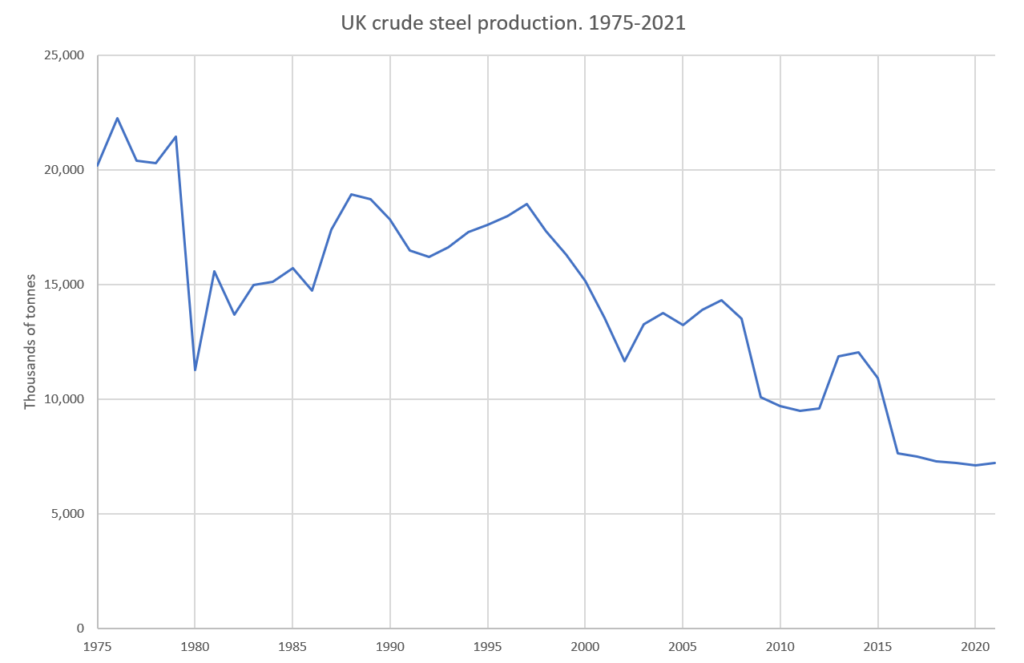- Emissions reduction targets are set without setting out how to achieve them.
- Reductions in emissions have largely been achieved by reductions in energy use, not technological advance or switching to renewables.
- A great deal of the energy use reduction has been achieved by driving industrial capacity and output abroad, which has no overall effect of reducing emissions and has a detrimental impact on the UK economy.
The UK government was one of the first to implement a ‘legally-binding’ emissions reduction target. In 2008, the Climate Change Act committed the country to an 80 per cent reduction in CO2 emissions by 2050, based on 1990s levels. This target was amended in 2019, to the ‘Net Zero’ target of effectively 100 per cent emissions-reduction. The UK government and the MPs that supported it (nearly all of them) believed that by acting unilaterally, other countries would be encouraged to develop similar policies, incorporating the targets established under the UN Framework Convention on Climate Change (UNFCCC), at the annual Conference of the Parties (COP) meetings in their own legislation.
The problem with such target-driven policies is that, though they are ‘legally-binding’, they have been established without there being any clear indication of how they will be achieved. At issue is the fact that, despite the claimed negative consequences of global warming and climate change, the abundance and affordability of energy from hydrocarbons has had extremely positive consequences for society. Those born in the late 19th and 20th centuries saw an improvement in their lives, and began to enjoy lifestyles that were unattainable and inconceivable to earlier generations, including intercontinental travel, private and mass transport, instant light and heat, agricultural surpluses – new and expanding industries, which transformed the economy and society. If technologically and economically viable alternative sources of energy can not be found, then radical emissions-reduction policies risk rolling back these advances made possible by hydrocarbon energy. That problem further implies an equally radical transformation of the relationship between the public and the state, and draconian policies enforced by the government on an unwilling country, thereby lacking democratic legitimacy.
In other words, target-based approaches put the policy cart before the technology horse. And because target-based policies were enacted so far in advance of policies that delivered the emissions-reduction, it was not possible for policymakers to produce a cost-benefit analysis. In the belief that innovation would follow policy and that ‘behaviour change’ (see section on psychology) could close the significant gap between the target and what green technology could deliver (63% according to the UK Climate Change Committee), politicians created a huge risk of democratic deficit, policy failure, huge expense and other unforeseen consequences.
Nonetheless, significant emissions-reduction seems to have been achieved in the UK. Between 2008 and 2020, UK CO2 emissions fell from 544 million tonnes to 330 million tonnes – a fall of nearly 40 per cent. This looks on its own terms like a policy success. However, significant factors may give a different account on this change. See section on Carbon ‘leakage’.



A closer examination of the sources that contributed to the UK’s total energy mix shows that whereas total energy consumption fell by 30.5 per cent between 2005 and 2020, renewable energy grew to just 16.4 per cent of the total by 2020, or just 11.4 per cent of the 2005 peak. This means that most (nearly two-thirds) of the UK’s emissions-reductions were not achieved by replacing fossil fuels with renewable energy, but by reduced demand.

Though this emissions reduction has been welcomed by greens, this loss of domestic production is a significant concern for economic and strategic reasons. For example, roughly speaking, the UK now imports about the same volume of steel that it produces. This means that the 5.7 million tonnes of steel produced in the UK caused the emissions of 10.5 million tonnes of CO2, as did its imports, though the emissions from the production of the imported steel are not counted in the UK’s total emissions inventory.
The UK’s reduction of coal use has been underway for decades enabled in large part by the increased exploitation of natural gas – especially in domestic heating, for which gas is vastly more convenient – and significant shifts in the country’s industrial sector. For example, in the 1960s, the UK was the world’s fifth largest steel producer. UK steel production has been in decline since then (data), because of global competition, and since 2008 steel production halved, in significant part because of the high costs of energy in the UK.


Critics point out, therefore, that much of the reduction of the UK’s emission has been the consequence of deindustrialisation and increased dependence on imports. In other words, emissions-reduction targets have caused only higher prices, not a meaningful ‘transition’ to ‘post-carbon’ energy and technology, and this will have broader economic, social and strategic consequences. These are non-trivial problems and, if critics are right, emissions-reduction policy-failures (unintended consequences) are likely to define the largest political crises that UK or EU-member governments have faced since WWII.
There is evidence that this is already happening. In the wake of the global lockdowns, economic recovery has triggered a supply crisis caused by years of underinvestment in the hydrocarbon energy sector. Further amplified by Russia’s invasion of Ukraine, high energy prices have revealed that many European countries, Germany in particular, which spent hundreds of billions of Euros on renewable energy, increased their dependence on energy imports (e.g. from Russia) rather than on developing net domestic energy production. Many EU member states, including Spain, Germany, France, Denmark, Ireland, and Portugal, passed legislation banning domestic fracking or oil and gas exploration, or both, in the 2010s as part of their green agenda. Additionally, many countries also used financial regulations to restrict private capital to international hydrocarbon energy projects, further to ESG reporting requirements being either developed as voluntary standards, or legislated for, by governments and their central banks and financial regulators. Consequently, European homes and industries are facing an uncertain winter.
